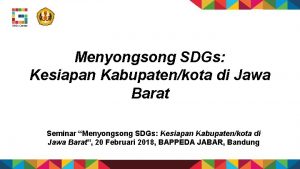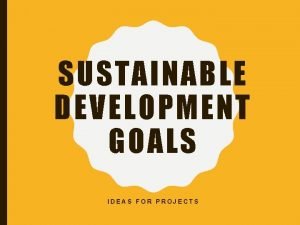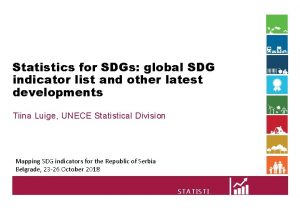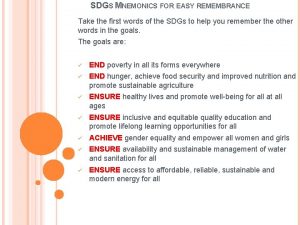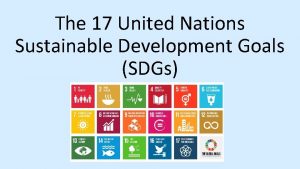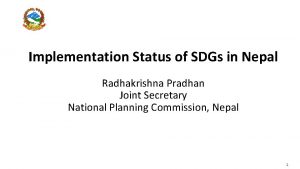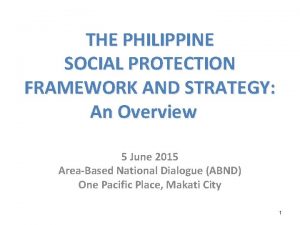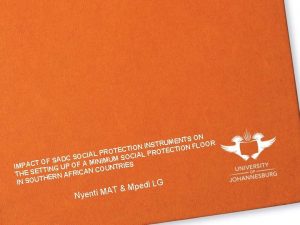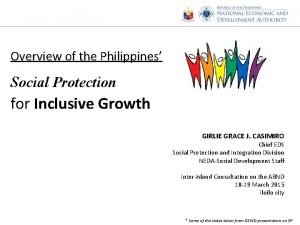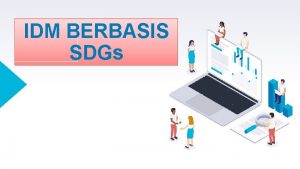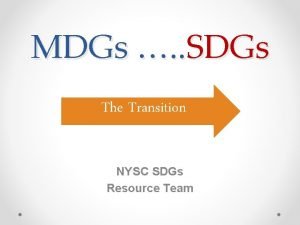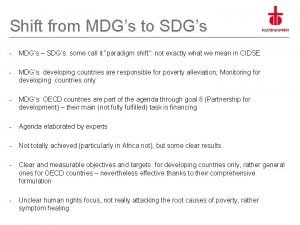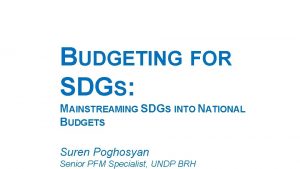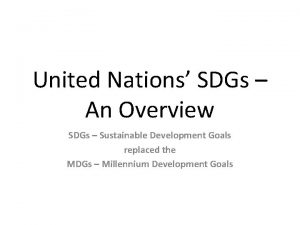Universal Social Protection to Achieve the SDGs The














- Slides: 14

Universal Social Protection to Achieve the SDGs The New Global Partnership for Universal Social Protection to Achieve the Sustainable Development Goals SPIAC-B Meeting, Algiers 27 April 2017

Universal Social Protection, the World Bank, the ILO and the SDGs § Universal coverage and access to social protection are central to ending poverty and boosting shared prosperity, the World Bank's twin goals by 2030. § Also at the core of the Social Protection Floors Recommendation, 2012 (No. 202), approved by world countries, endorsed by the UN and the G 20 § World countries have also agreed on SDG 1. 3 “Implement nationally appropriate social protection systems and measures for all, including floors, and by 2030 achieve substantial coverage of the poor and the vulnerable”

A Story of More than 100 Years: Building Social Protection Systems … Rapid Expansion since 2000 s Source: World Social Protection Report 2014 -15, ILO

Many countries have put in place universal social protection schemes: Argentina • Armenia • Azerbaijan • Belarus • Bolivia • Botswana • Brazil Brunei • Cabo Verde • Chile • China • Cook Islands • Georgia • Guyana India Kazakhstan Kiribati Kosovo Kyrgyz Republic Lesotho Maldives Mauritius Mongolia Namibia Nepal • • • Example: China Samoa Expansion of old-age Seychelles pension coverage over South Africa 2001 -2013 Swaziland Number of people covered (in Tanzania millions) 900 (Zanzibar) 700 Thailand Timor-Leste 500 300 Trinidad Tobago 100 Ukraine Uruguay Source: universal. social-protection. org Uzbekistan 20 01 20 02 20 03 20 04 20 05 20 06 20 07 20 08 20 09 20 10 20 11 20 12 20 13 • • • •

…and many development partners working together to promote Universal Social Protection Systems See: www. universal. social-protection. org

Universal Social Protection for Shared Prosperity and Recommendation 202 Social Protection Floors Children Child Support Working age Old age Support for those without jobs Maternity Work Injury Disability Benefits Access to Health Old Age Pension, Survivors Safety nets for the poor

Many paths to Universal Social Protection Governments have a wide set of options to achieve universal social protection. South-South learning shows: § Some countries opted for immediate universal coverage – eg. Botswana, Timor Leste. § Others gradual and progressive approach – eg. Brazil, Thailand. § Some have universalism embedded in their national constitutions - eg. Bolivia, South Africa. § Others have achieved universalism without any similar constitutional provisions eg. Swaziland, Uruguay. § Universal social protection is most commonly started with old-age pensions, but some countries have opted to universalize in parallel disability, maternity and/or child benefits. Eg. Argentina, Nepal. • Some provide a publicly-financed social pension/benefit to all – eg. Mongolia, Namibia. • Others provide a minimum pension to those who do not have a contributory pension, ensuring universality - eg. Azerbaijan, China. • Strategic use of transfers to the poor and vulnerable who are not reached out by other social protection schemes-Brazil, Chile, Georgia.

Reduces poverty and inequality Lessens social tensions and conflict Builds political stability Increases consumption and aggregate demand Supports crisis response and structural change Promotes economic growth Better access to food and better nutritional status Improved health Higher utilization of health services Higher school attendance and reduction in child labour Better educational performance Facilitates search for jobs and riskier decision-making Promotes productive employment and entrepreneurship Increases human development and productivity Inclusive growth and human development Social Protection: Demonstrated Results

14. Strategies for Universal Social Protection Systems, including floors • (a) Start national dialogue and call relevant stakeholders, including employers, workers, UN and development partners • (b) identify gaps in social protection; • (c) determine appropriate social protection schemes, whether contributory or non-contributory, or both, as well as the time frame and sequencing for the progressive achievement of the objectives • (d) Cost selected schemes, identify potential fiscal space • (e) Discuss financial and human resources with Ministry of Finance • (f) Agree national strategy through national social dialogue 9

What’s Next? § At the launch, it was agreed to FORMALIZE THE PARTNERSHIP § Objective, as agreed in the Concept Note, is “to increase the number of countries that can provide universal social protection, supporting countries to design and implement universal and sustainable social protection systems. ” § Governance structure will have to be formalized, led by the WBG and ILO, the partnership is open to interested SPIAC-B members and others; § Once the governance structure is effective, draft an Action Plan § Need to fast-track progress to formalize the initiative

Proposal: • Name: Global Partnership on Universal Social Protection – USP 2030 • Objective: To increase the number of countries that can provide universal social protection, supporting countries to design and implement universal and sustainable social protection systems • Partnership base: • Led by the WBG and ILO, the partnership is open to interested SPIAC -B members and others; governments, government agencies, development banks, CSOs, private sector, academia, research institutions, etc. • Any new partner would formally declare the partnership and contribute to it in cash or in kind (eg. Country briefs etc). • To make the partnership process formal (request of President Kim and DG Ryder), it should be agreed in Steering Committee meetings, and afterwards both WBG, ILO and members should have on their respective websites something like a set of conditions of membership, as regards values such as equity, universality, SDGs, etc.

• Steering Committee: Proposal: • WB and ILO as permanent co-chairs • A rotating group of one or three more partners (possibly: representatives of bilateral organizations, CSOs and the UN system etc. ). The rotating members of the Steering Committee are proposed annually based on clear and transparent criteria agreed by the partners and approved at the Membership Meeting. • Membership meetings: § Once per year. Could be organized as a side event to the General Assembly meeting in September or it could be linked to a SPIAC-B meeting. § Could also include a partners’ fair where countries would present their successes, etc. , trade ideas, share knowledge and experience, etc. ).

Proposal: • Activities: 1. Advocacy for USP 2030 by working both at the global level and with respective country counterparts on principles of universal social protection 2. Resource mobilization 3. Knowledge generation and exchange on USP 2030, including developing and demonstrating good practices in social protection policies, programs and delivery systems, costing and financing of programs and an assessment of program performance. 4. Facilitating and coordinating in country support for universal social protection supporting country assessments of SP systems, program design and implementation. 5. Annual progress reports, including monitoring progress in countries.

Thank you http: //universal. social-protection. org
 Sdgs jawa barat
Sdgs jawa barat Sdgs project ideas
Sdgs project ideas Sdgs list
Sdgs list Mnemonic for sustainable development goals
Mnemonic for sustainable development goals Https://sustainabledevelopment.un.org/sdgs
Https://sustainabledevelopment.un.org/sdgs Pilar sosial sdgs
Pilar sosial sdgs Sdgs 2030
Sdgs 2030 Elina bardram cv
Elina bardram cv Federation business school
Federation business school Subject matter in auditing
Subject matter in auditing Social thinking social influence social relations
Social thinking social influence social relations Social thinking social influence social relations
Social thinking social influence social relations Social protection operational framework philippines
Social protection operational framework philippines Social protection instruments
Social protection instruments Social protection operational framework philippines
Social protection operational framework philippines
